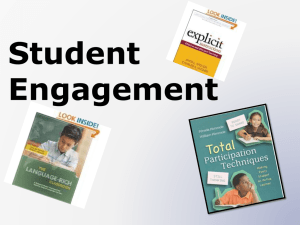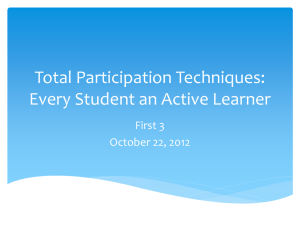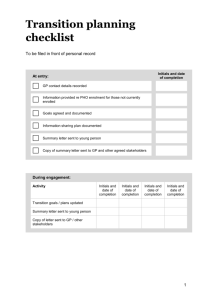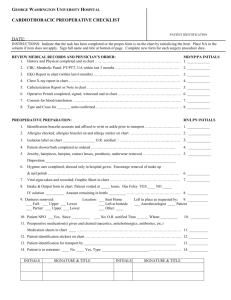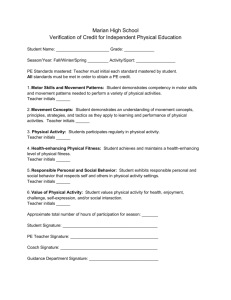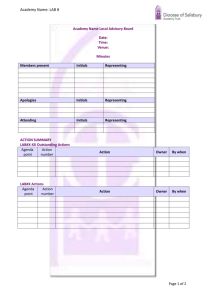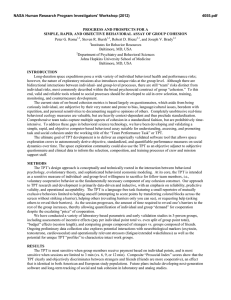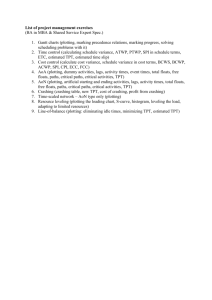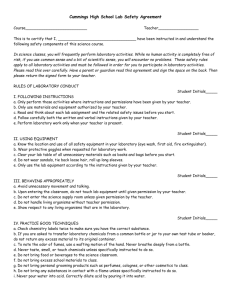Total Participation No Opt Out Strategies to promote
advertisement
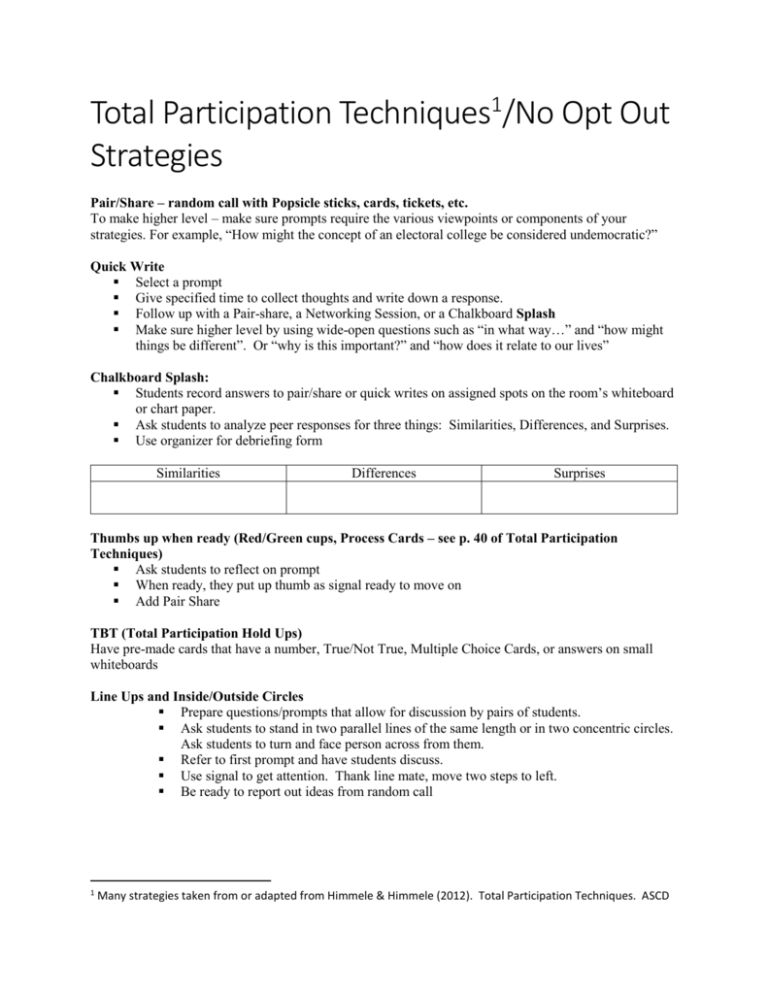
Total Participation Techniques1/No Opt Out Strategies Pair/Share – random call with Popsicle sticks, cards, tickets, etc. To make higher level – make sure prompts require the various viewpoints or components of your strategies. For example, “How might the concept of an electoral college be considered undemocratic?” Quick Write Select a prompt Give specified time to collect thoughts and write down a response. Follow up with a Pair-share, a Networking Session, or a Chalkboard Splash Make sure higher level by using wide-open questions such as “in what way…” and “how might things be different”. Or “why is this important?” and “how does it relate to our lives” Chalkboard Splash: Students record answers to pair/share or quick writes on assigned spots on the room’s whiteboard or chart paper. Ask students to analyze peer responses for three things: Similarities, Differences, and Surprises. Use organizer for debriefing form Similarities Differences Surprises Thumbs up when ready (Red/Green cups, Process Cards – see p. 40 of Total Participation Techniques) Ask students to reflect on prompt When ready, they put up thumb as signal ready to move on Add Pair Share TBT (Total Participation Hold Ups) Have pre-made cards that have a number, True/Not True, Multiple Choice Cards, or answers on small whiteboards Line Ups and Inside/Outside Circles Prepare questions/prompts that allow for discussion by pairs of students. Ask students to stand in two parallel lines of the same length or in two concentric circles. Ask students to turn and face person across from them. Refer to first prompt and have students discuss. Use signal to get attention. Thank line mate, move two steps to left. Be ready to report out ideas from random call 1 Many strategies taken from or adapted from Himmele & Himmele (2012). Total Participation Techniques. ASCD Three 3’s in a Row Prepare 9 questions in the Three 3’s template Students walk around the room asking peers to explain ONE answer to them. Students summarize their peer’s responses in the boxes. (Students must write on their own paper summarizing another’s response.) Students find another peer to answer another question. You can either go through all 9 questions (black out) or 3 in a row (Bingo) Go over answers in the class. Provide a definition for TPT Initial _______ Explain how you plan to implement at least two TPT’s next week Initials ____ Describe an interesting experience with TPT and discuss how it enhanced learning. Initials _____ What is the most essential ingredient in TPT conducive classroom Initials ______ Explain how TPT’s might have helped you during your own school experience. Initials ___ Pretend you are talking to a parent, explain why you are using TPT’s Initials ____ Explain which TPT’s in your opinion, would do the most to ensure higher level thinking. Initials______ Describe how TPT’s can lessen the achievement gap. Initials______ Explain how including TPT has changed how you plan your lesson. Initials______ Example adapted from p. 63 A/B Partners and then random Call Partner A talks to Partner B. B stands up and is ready to share what partner A said. Swap roles with next prompt. I don’t know is not an option instead… • “phone a friend” • say, “what do you know about this topic?” • Say, “if you did know, what answer might you give?” • come back to the person and have them repeat the answer from someone else. Ask a student to summarize another student’s answer using random methods Swap Meet Students write answers on three cards and walk around and verbally share answer and trade card. Numbered heads together In your team, number off 1-3. Up and out of chair Heads together Team voices Sit when ready to share • Ask question for group to answer/discuss • Call on a random number between 1 and 3 and that person will share out selections for the group Table Map Stirring the Paint Give a prompt where students have to share an original thought or belief (Example, the most important contributing factor to poverty in America is… because…) Have students partner up. Students individually write their one sentence answer on an index card. No name on the card. They trade their card with someone who is not their partner. The partners get together with the two new cards and decide the level they agree with the statements on the two cards (allow for discussion time because this is the meat of the activity). The partners assign a number to each of the two cards and the number totals of the cards need to total 7. The number is written on the card. (For example, if they agree with one card a lot, and another one not so much, they would assign and write 6 on one card and 1 on the other (6+1=7) Repeat the process to get 2 new cards, the partners add new numbers (totaling 7) to the new cards. Repeat the process one more time. Teacher asks for any card whose 3 numbers written on it =21 (perfect idea to everyone that read it). Count down from 21 and have students share those thoughts so others can hear them. Bounce Cards 1. Select a student to practice modeling the a conversation with the class to observe. 2. Model the “wrong way” to hold a conversation (ending quickly) 3. Discuss the following three approaches to responding to peers’ comments: a. Bounce: Students take what their peers say and bounce and idea off of it (or extend the idea). b. Sum it up: Students rephrase what their peers say and comment on certain pars. c. Inquire: Students ask a question regarding what their peers say 4. Model a conversation 5. Allow students to practice Example Card: Bounce: Take what your classmate(s) said and bounce and idea off of it. For example, you can start your sentence with – “That reminds me of…” “I agree, because….” “True. Another example is when…” “That’s a great point….” Sum it up: Rephrase what was said in a shorter version. For example, you can start your sentences with “I hear you saying that…” “So, if I understand you correctly….” “I like how you said….” Inquire Understand what your classmates mean aby asking them questions. For example, you can start your questions with – “Can you tell me more about that?” “I’m not sure I understand….” “I see your point, but what about….?” “Have you thought about….”
